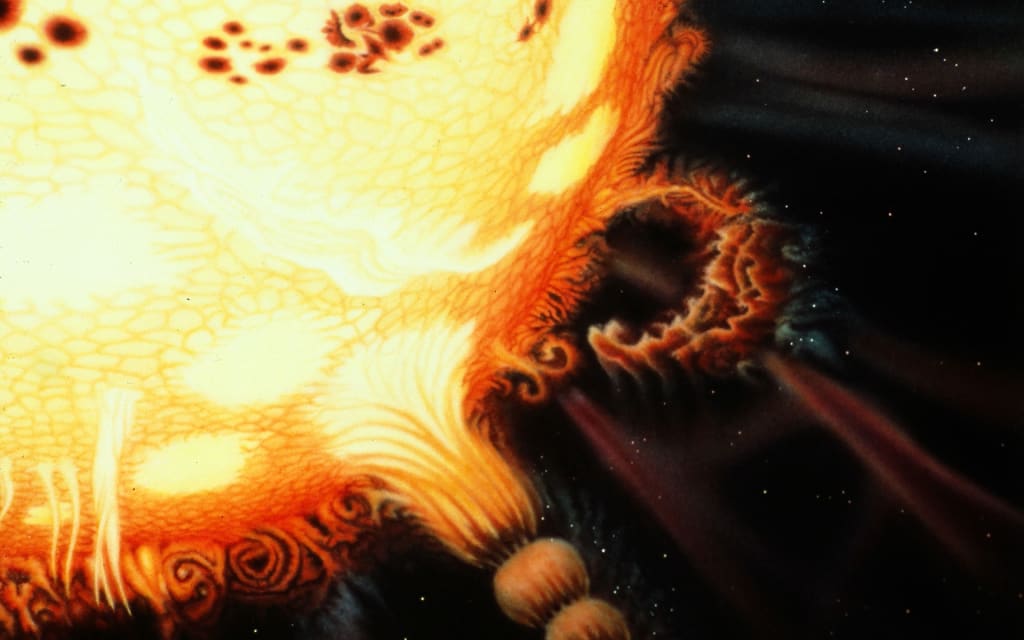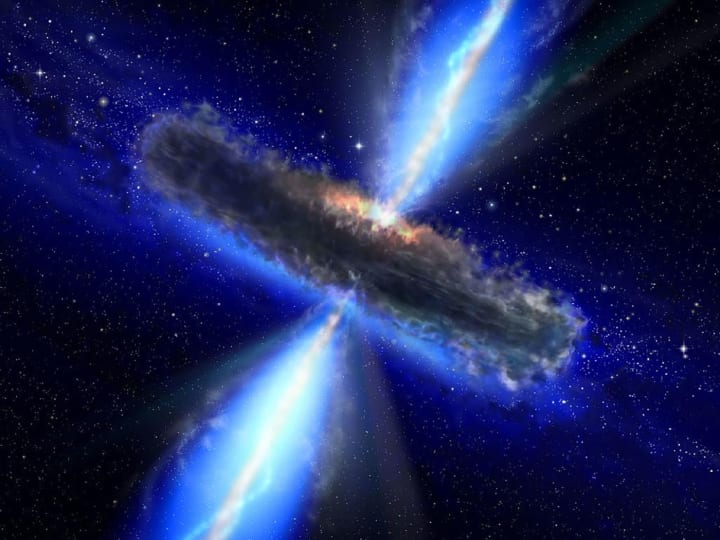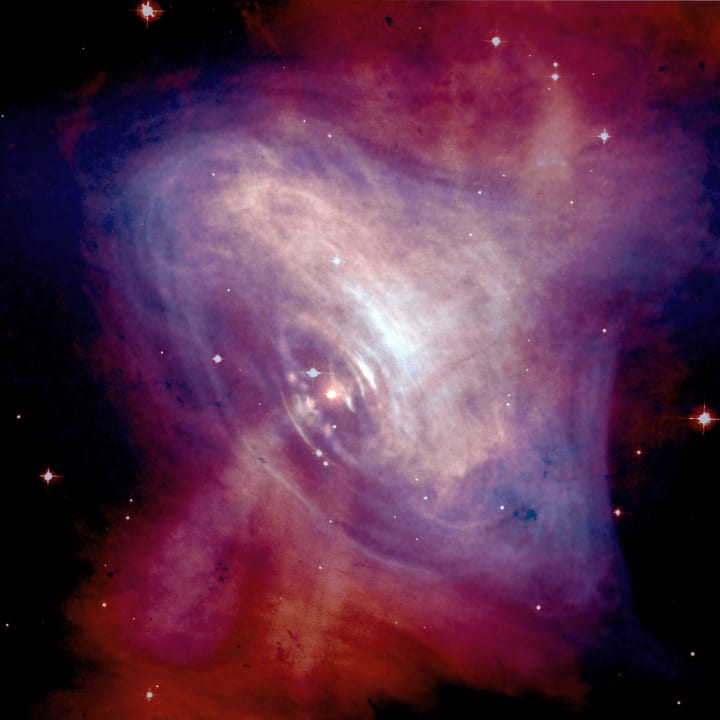Mystery of Quasars
Decades after their discovery, quasars still maintain their mystery.

Quasar! The very name evokes visions of vast power, primordial matter, the brightness of a trillion suns, mystery.
In the decades since these curious objects were first identified, the mystery of quasars has broadened and deepened. Many astrophysicists think that quasars were only one type in a wide range of energetic extragalactic phenomena. A decade after their discovery, Britain's Dr. Martin J. Rees even called for a whole new classification scheme to replace the helter-skelter assortment of terms that was in use for high-powered radio sources with terms that recognize their basic similarity.
Radio Astronomy
In the 1950s, radio astronomy was just getting up steam. As radio sources were discovered, astronomers tried to match them with objects seen and photographed through conventional telescopes. Some radio sources turned out to be nebulas—clouds of gas and dust within our Milky Way galaxy. Others were far from our city of stars; They were, in fact, galaxies in their own right. Still others seemed to be single stars—mere points of light on photographs of the areas of sky from which the radio waves came. Early names for these were "quasi-stellar radio source," "quasi-stellar object," and their acronyms QSRS and QSO. "Quasar," probably the most glamorous term in the astronomer's lexicon, is the one that has survived.
Wondering what these "radio stars" might be, optical astronomers spread their light into a spectrum displaying all the different wavelengths. The spectrum revealed a swath of light overlaid by bright and dark lines, particular wavelengths where the intensity of radiation is enhanced or diminished by the material of the star.
Now it is well known that each chemical element emits and absorbs light of particular wavelengths under specific conditions. Thus, to the trained eye, the lines in a spectrum form a dossier of the elements that are present in the source and the physical conditions that exist there—pressure, temperature, density, and so on.
But the lines in the spectrum of the quasars matched no known chemical elements!
Schmidt’s Spectrums
In 1963, Caltech astronomer Maarten Schmidt had a brilliant insight, the kind of inspiration that is based on many years of fruitful research but that transcends the usual methodical pace of scientific investigation.
Schmidt realized that the lines in the spectrum of one quasar could be explained if he assumed that the quasar was moving away from us very fast. When an object is receding from us, the Doppler effect shifts the wavelengths of the light we see toward the red end of the spectrum. This effect could have shifted normally invisible ultraviolet lines red-ward into the visible portion of the spectrum. If this were so, the quasar must be whizzing away from Earth at fully one tenth the speed of light!
The quasar was, therefore, surely not a star, for it would have escaped from the gravitational confines of the galaxy long ago. The quasar must be out among the galaxies, millions of light-years away in space. If it is that far distant, it must be exceptionally luminous to appear as bright as it seems to us. Even more puzzling, because it appears as but a point of light even with the post powerful telescopes, it must be very small on a cosmic scale—perhaps too small to produce all that radiated energy by any means within current theory.
We know the active parts of quasars must be small, since they vary their light output in a short period of time—weeks, even days. If such an object is to drastically change its brightness, all parts of it must change in phase. Uncoordinated changes would cancel out and produce only a weak flickering. Something must then coordinate all parts of the quasar. Some signal must go from one side to tell the other side to change. The fastest information carrier the laws of relativity permit is light, so if an object varies coherently within a day it must be no bigger than a light-day across.
Now a light-day is about 26 billion kilometers, twice the diameter of the solar system and incomprehensibly enormous on a human scale. Cosmically, it is tiny—the nearest star is four light-years, more than 1,400 times as far away—especially when you consider how much energy is coming from that volume. Tiny as they are, a typical quasar might continuously radiate as much energy as a trillion suns—10 to 100 times the output of our entire galaxy.

via Space
Varying Quasars
Some quasars are surrounded by a faint haze. Others spew out jets of material at tens of thousands of kilometers per second. Still, other quasars do not radiate any radio waves. About 95 percent of the quasars are radio quiet. Thus the term quasar—meaning "quasi-stellar radio source"—is inaccurate. Some astronomers think we may have to change it, others think it may come to encompass a broader range of energetic cosmic denizens.
The first of these was found in 1929, when a faint object in the obscure constellation of Lacerta (the Lizard) was observed to vary in brightness. It was, as is customary, given a two-letter designation in a catalog of variable stars and so became BL Lacertae.
In the 1970s they had realized that BL Lacertae is anything but a star. It is a cousin of the quasar, a cousin that sometimes even outshines its older relative. Several dozen similar objects have been discovered in succeeding decades. Astronomers call them BL Lacertae objects or BL Lacs or lacertae or lacertids. One astronomer jokingly suggested they would be more glamorous if they were dubbed "blazars."
BL Lacertae objects resemble quasars in being almost stellar in appearance. They show few spectral lines, if any. This makes it difficult, even impossible, to determine their distances. Some are intrinsically brighter than quasars. When one of these puzzling bodies brightened in the early 1970s, it temporarily became the most luminous object in the known universe.
Photographic Evidence
Photographs of some BL Lacertae objects show that they are surrounded by a faint haze of light that displays a spectrum similar to that of an elliptical galaxy. This ties in well with models of quasars as the energetic centers of spiral galaxies.
There may also be a connection with yet another type of object, known as Seyfert galaxies. Sixty-five years ago, astronomer Carl Seyfert noticed that some spiral galaxies have very bright centers. Something very energetic is going on in their nuclei. There are also N galaxies—elliptical galaxies with extraordinarily bright nuclei.
All these strange objects may be different manifestations, perhaps different stages of evolution, of the same basic phenomenon, according to one theory. Even galaxies usually considered "normal" may fit in. The otherwise unremarkable spiral galaxy we live in has a very intense source of radio and infrared radiation at its center

Energy Source is Unknown
The big problem that needs answering for all these unusual objects is their source of energy. How can such small volumes produce such prodigious amounts of energy all across the spectrum, from X-rays to radio waves? How can they last billions of years? Astronomical journals have been rife with conjectures and speculations since quasars were discovered.
Among the ideas proposed as power sources are black holes, white holes (which eventually evolve into black holes), colliding stars, chain reactions of supernovas, and huge spinning superstars or groups of stars called spinars.
The supernova model envisions many massive stars in a tight cluster exploding one by one, or in groups, each explosion setting off others. Collisions of stars in such a cluster may trigger fierce thermonuclear outbursts. This model has fallen into disfavor as it fails to explain some of the observed properties of quasars.
Stunning Symmetry
There is increasing evidence for symmetry on the part of BL Lacertae objects and quasars. This symmetry not predicted by the supernova theory, leads to models in which the quasar is rotating. Material is pulled into a cosmic vortex, transmuting gravitational potential energy into intense heat and radiation, slinging material out into giant lobes of radio energy around the center.
At the center of the maelstrom could be either a black hole or a spinar. Around the central object is an "accretion disk"—a region where the inflowing matter collects. As it comes together and is compressed, it heats to about 10,000 degrees, not hot on an astrophysical scale but hot enough to shine brightly across millions of light-years. The complex interaction of the central mass, the inflowing material and the out-flung material, and the accretion disk and the radiation go to make the quasar, and maybe BL Lacertae objects, as well.
Astronomers speculate that perhaps all galaxies, or maybe just galaxies of certain types, go through stages of being quasars and BL Lacertae objects, then quiet down. Other astronomers suggest that quasars and BL Lacertae objects are the same kind of bodies seen from different angles. Or perhaps there are different degrees of "quasar hood," with our Milky Way at the low end of the energy scale and BL Lacertae objects shining brightly near the high end.
Hampered in our research by the great remoteness of the quasars and their kin and by the dust that intervenes between us and the center of our galaxy. Both make it difficult to see the details we would wish. There is little hope that we will conquer this difficulty.
About the Creator
Mark R. Chartrand III
Published author and editor; Works include Night Sky: A Guide To Field Identification, Stars, and Planets: A Guide to the Solar System.






Comments
There are no comments for this story
Be the first to respond and start the conversation.